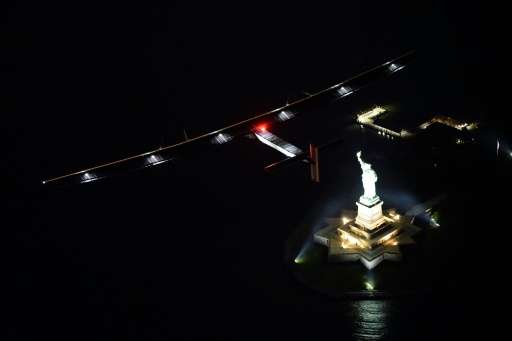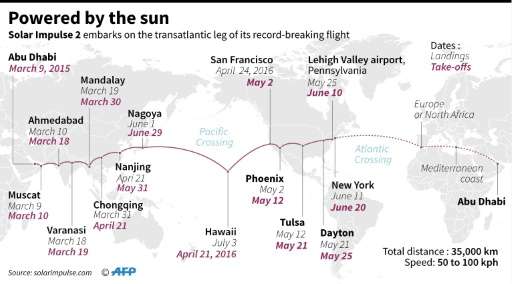Solar Impulse 2 took off from New York's John F. Kennedy airport piloted by Swiss adventurer Bertrand Piccard, who is expected to spend between 90 and 110 hours crossing the Atlantic en route to Spain
The Solar Impulse 2 aircraft passed the halfway mark of its marathon flight across the Atlantic late Tuesday, one of the most challenging legs of its historic sun-powered journey around the world.
The experimental plane, which took off from New York's John F. Kennedy airport on Monday, is being piloted by Swiss adventurer Bertrand Piccard, who is expected to spend between 90 and 110 hours crossing the Atlantic en route to Spain's Seville Airport.
At about 7:15 pm New York time (2330 GMT), the plane was halfway to its destination, the Solar Impulse organization said on Twitter.
Less than an hour later, it was flying over the tiny Azores islands. A live feed showed Piccard flying through complete darkness.
The plane is powered in the night sky by the energy stored in its 17,000 photovoltaic cells.
The voyage marks the first solo transatlantic crossing in a solar-powered airplane and is expected to last up to four consecutive days, depending on weather.
The first day in Piccard's ocean-crossing saw whales cavorting in the waters beneath the plane, a gorgeous full moon in the nighttime sky, and more.
"You will not believe me, but to my right, I see an iceberg in the Atlantic Ocean. Check it out!" Piccard wrote on the online blog he and fellow pilot Andre Borschberg have been keeping.
Solar Impulse 2
Piccard, who is taking catnaps during the marathon flight, has sounded exhausted but exhilarated by the challenge.
"Just got up from resting," he wrote on his Twitter account shortly after 0600 GMT, as day was breaking.
"Still a little tired but happy to see the sunrise while sitting in my little #Si2 home."
No heavier than a car but with the wingspan of a Boeing 747, Solar Impulse is being flown on its 22,000-mile (35,400-kilometer) trip in stages, with Piccard and his Swiss compatriot Borschberg taking turns at the controls of the single-seat plane.
Borschberg piloted the flight's final Pacific stage, a 4,000-mile flight between Japan and Hawaii that lasted 118 hours, smashing the previous record for the longest uninterrupted journey in aviation history.
The plane, now on the 15th leg of its east-west trip, set out on March 9, 2015 in Abu Dhabi, and has flown across Asia and the Pacific to the United States with the sun as its only source of power.
The plane typically travels at a mere 30 miles per hour, although its flight speed can double when exposed to full sunlight.
© 2016 AFP

























